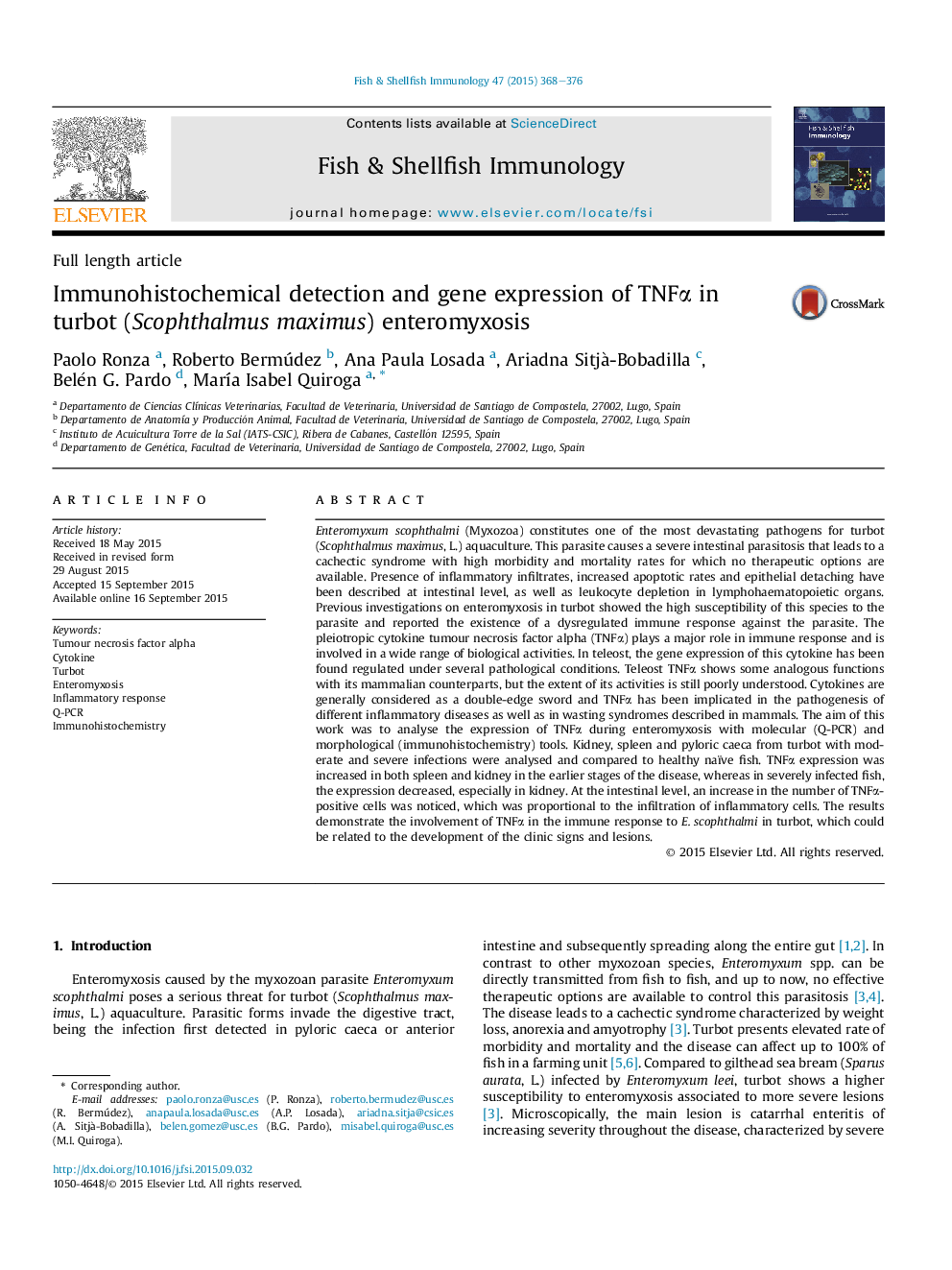| کد مقاله | کد نشریه | سال انتشار | مقاله انگلیسی | نسخه تمام متن |
|---|---|---|---|---|
| 2431101 | 1106744 | 2015 | 9 صفحه PDF | دانلود رایگان |
عنوان انگلیسی مقاله ISI
Immunohistochemical detection and gene expression of TNFα in turbot (Scophthalmus maximus) enteromyxosis
دانلود مقاله + سفارش ترجمه
دانلود مقاله ISI انگلیسی
رایگان برای ایرانیان
کلمات کلیدی
موضوعات مرتبط
علوم زیستی و بیوفناوری
علوم کشاورزی و بیولوژیک
علوم آبزیان
پیش نمایش صفحه اول مقاله

چکیده انگلیسی
Enteromyxum scophthalmi (Myxozoa) constitutes one of the most devastating pathogens for turbot (Scophthalmus maximus, L.) aquaculture. This parasite causes a severe intestinal parasitosis that leads to a cachectic syndrome with high morbidity and mortality rates for which no therapeutic options are available. Presence of inflammatory infiltrates, increased apoptotic rates and epithelial detaching have been described at intestinal level, as well as leukocyte depletion in lymphohaematopoietic organs. Previous investigations on enteromyxosis in turbot showed the high susceptibility of this species to the parasite and reported the existence of a dysregulated immune response against the parasite. The pleiotropic cytokine tumour necrosis factor alpha (TNFα) plays a major role in immune response and is involved in a wide range of biological activities. In teleost, the gene expression of this cytokine has been found regulated under several pathological conditions. Teleost TNFα shows some analogous functions with its mammalian counterparts, but the extent of its activities is still poorly understood. Cytokines are generally considered as a double-edge sword and TNFα has been implicated in the pathogenesis of different inflammatory diseases as well as in wasting syndromes described in mammals. The aim of this work was to analyse the expression of TNFα during enteromyxosis with molecular (Q-PCR) and morphological (immunohistochemistry) tools. Kidney, spleen and pyloric caeca from turbot with moderate and severe infections were analysed and compared to healthy naïve fish. TNFα expression was increased in both spleen and kidney in the earlier stages of the disease, whereas in severely infected fish, the expression decreased, especially in kidney. At the intestinal level, an increase in the number of TNFα-positive cells was noticed, which was proportional to the infiltration of inflammatory cells. The results demonstrate the involvement of TNFα in the immune response to E. scophthalmi in turbot, which could be related to the development of the clinic signs and lesions.
ناشر
Database: Elsevier - ScienceDirect (ساینس دایرکت)
Journal: Fish & Shellfish Immunology - Volume 47, Issue 1, November 2015, Pages 368-376
Journal: Fish & Shellfish Immunology - Volume 47, Issue 1, November 2015, Pages 368-376
نویسندگان
Paolo Ronza, Roberto Bermúdez, Ana Paula Losada, Ariadna Sitjà -Bobadilla, Belén G. Pardo, MarÃa Isabel Quiroga,